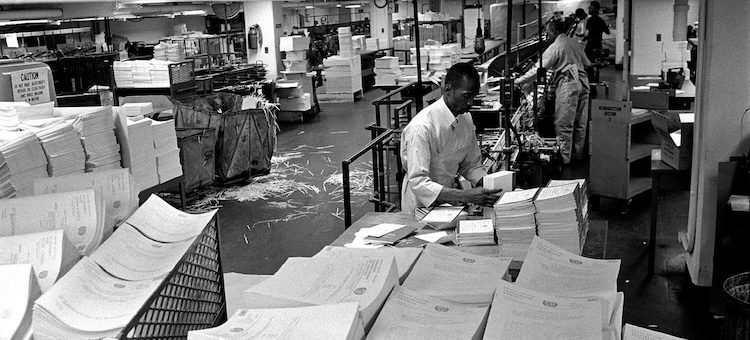By Stephanie Hodge*
NEW YORK | 1 August 2025 (IDN) — The UN has never been short on words. It’s drowning in them. Every year, thousands of meetings convene, resolutions multiply like rabbits, and the ink dries on mandates so outdated they might as well be written in Morse code.
The recently released Mandate Implementation Review under the UN80 Initiative confirms what many of us have whispered in policy backrooms for years: the system isn’t just bloated—it’s addicted to its bureaucracy.
Since 1946, over 40,000 mandates have been issued by the General Assembly, Security Council, ECOSOC, and their subsidiaries. But shockingly, more than 30% of General Assembly resolution topics from 1990 are still on the agenda in 2024—often debated without evolution, impact, or accountability.
This is not multilateralism. It’s procedural necromancy.
Let’s call this what it is: mandate inertia. A system where old resolutions are endlessly recycled, entities cite the same mandates without coordination, and new tasks are tacked on “within existing resources,” even as budgets shrink.
At a time when children are starving in Gaza, climate migrants are drowning in the Mediterranean, and UN credibility teeters on the brink, we simply cannot afford this level of systemic redundancy.
The Power to Mandate Is the Power to Bury
What the UN80 report reveals—but won’t dare say outright—is that Member States themselves have turned mandates into a form of diplomatic performance art. Resolutions are now longer, vaguer, and increasingly disconnected from funding realities.
Since 2020, the average word count of GA and ECOSOC resolutions has surged by over 50%. More mandates, fewer resources, less flexibility. The perfect formula for dysfunction.
Meanwhile, nearly half of all mandates now specify exactly which entity must implement them—regardless of capacity, comparative advantage, or strategic coherence. This strips the Secretary-General of the ability to lead and turns reform into rearranging deck chairs on a ship drifting into irrelevance.
Fragmentation by Design
The fragmentation isn’t accidental—it’s baked into the funding model. Over 85% of UN system funding comes from earmarked voluntary contributions. Most grants are under $1 million. Pooled funding—the only real antidote to duplication—is shrinking. No wonder 20+ entities are tripping over each other to claim delivery on every SDG. The mandate landscape isn’t just crowded; it’s a minefield of institutional self-interest.
As the report puts it gently, many UN entities “cite the same mandates,” often without coordination. Let’s translate: entities justify their existence by stapling themselves to mandates they can’t—or shouldn’t—deliver. Meanwhile, core resources wither, and the Secretariat is left delivering on 4,000 resolutions with only 5% of total UN funding.
The Road Not Taken
The UN80 report is careful, almost apologetic in tone. It proposes better mandate registries, more AI tools to check for duplication, and shorter, sharper resolutions. Fine. Necessary even. But not sufficient.
We don’t need better tools to track bureaucratic clutter. We need the courage to clear it. That means: Mandatory sunset clauses for all new mandates.
An independent Mandate Audit Board to recommend retirement, merger, or realignment based on relevance and impact.
A comparative advantage test—no UN entity should cite a mandate unless it can prove unique value-add.
A political ceiling: no new mandates should be adopted without the resources to fund them.
Who Guards the Guardians?
Mandates are supposed to reflect the will of Member States. But that doesn’t absolve the UN system from responsibility. It’s time for the Secretariat to stop pleading for “flexibility” and start insisting on it. Mandates that are unfunded, duplicative, or unreviewed should be publicly flagged—not quietly absorbed.
The true accountability gap lies not in poor delivery, but in the refusal to challenge the premise of permanent relevance. As long as every Member State clings to its pet resolutions and every agency protects its turf, we’ll keep spinning in circles—reporting more, doing less, and changing nothing.
Conclusion: Reform Begins with Letting Go
If we want a UN fit for purpose by its centenary, we must start by asking the one question no committee wants to hear:
“What are we willing to stop doing?”
The answer may be uncomfortable. But until we clear out the mandates that no longer serve us, we’ll never have the space—or the spine—to meet the mandates that actually do.
*Stephanie Hodge is an international evaluator and former UN advisor who has worked across 140 countries. She is a former staffer of UNDP (1994-1996 & 1999-2004) and UNICEF (2008-2014). She writes on governance, multilateral reform, and climate equity. [IDN-InDepthNews]
Image: Thousands of pages of documents used to be printed every day at the UN as pictured in June 1969. UN Photo/Yutaka Nagata


